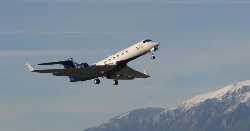AIRCREW SAFETY & HEALTH

Photo courtesy of Julie Haggerty (NCAR)
Respiratory Symptoms and Diseases
What you need to know
Some studies suggest that aircrew may be more likely than other workers to have respiratory symptoms and diseases. Many crewmembers were exposed to secondhand smoke when smoking was allowed on aircraft, and this may have increased their risk. Some communicable diseases and other exposures in the aircraft may also play a role. Here you can learn about steps you can take to reduce your risk.
What is known about respiratory symptoms and diseases in aircrew?
- Some studies suggest that respiratory symptoms and diseases including irritated, stuffy or runny nose, dry throat, chest illness, cold or flu, wheezing, and chronic bronchitis are more common in flight attendants than other workers.
- There is less information about respiratory symptoms and diseases among cockpit crew, but some data suggest they may be more likely to have respiratory symptoms as well.
- Many crewmembers were exposed to secondhand smoke when smoking was allowed on aircraft. They can still be exposed to secondhand smoke in some airports.
- Communicable diseases that cause respiratory symptoms may be transmitted during air travel.
- Other exposures on aircraft can cause respiratory symptoms including pesticides.
What is not known?
Secondhand smoke in aircraft may cause asthma, worsening of asthma control, respiratory symptoms, COPD (chronic obstructive pulmonary disease) and decline in lung function in adults.
For more information
- CDC: Respiratory Infections
- If you have safety and health questions about your job contact us
- Page last reviewed: May 9, 2017
- Page last updated: May 9, 2017
- Content source:
- National Institute for Occupational Safety and Health Division of Surveillance, Hazard Evaluations and Field Studies


 ShareCompartir
ShareCompartir